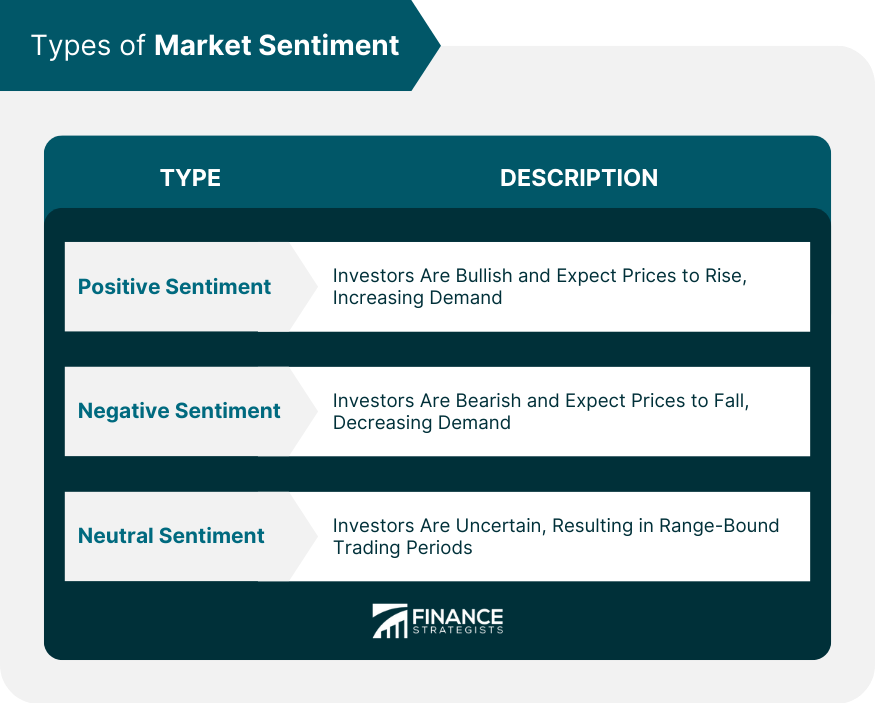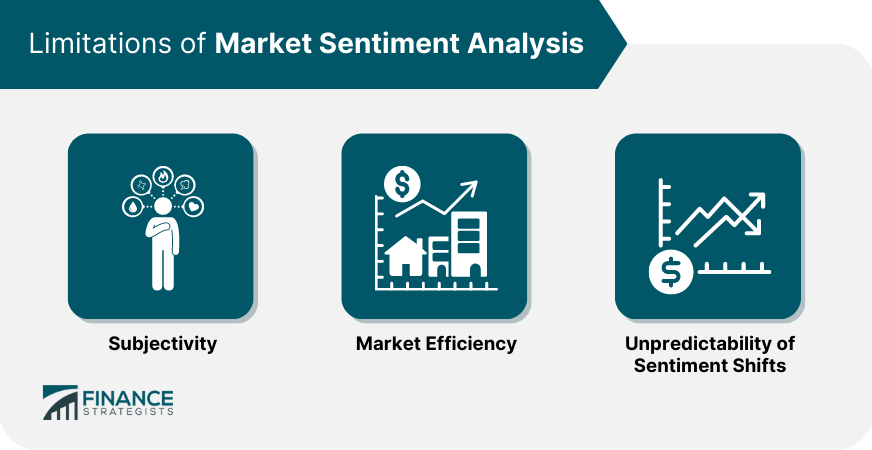Market sentiment analysis is the study of the overall attitude of investors toward a particular market or financial instrument. Understanding market sentiment is crucial for investors and traders, as it can help them make informed investment decisions by evaluating the prevailing mood in the market. Positive market sentiment, also known as bullish sentiment, occurs when investors have a favorable outlook on the market or a particular asset. They expect prices to rise and are more likely to buy, resulting in increased demand and higher prices. Negative market or bearish sentiment is the opposite of bullish sentiment. Investors expect prices to fall, leading to a pessimistic outlook on the market. They are more likely to sell, which results in decreased demand and lower prices. Neutral sentiment occurs when investors are unsure about the market's direction, and there is no clear consensus about whether prices will rise or fall. In such situations, the market may experience consolidation or range-bound trading periods. Economic indicators play a vital role in shaping market sentiment, as they provide insights into the economy's overall health. Some key economic indicators include: Gross Domestic Product (GDP): A measure of the total value of goods and services produced by a country over a specific period. Unemployment Rate: The percentage of the labor force that is actively seeking employment but unable to find work. Inflation: The rate at which the general price level of goods and services in an economy is increasing over time. Interest Rates: The cost of borrowing money, set by central banks, which can influence economic growth and inflation. Political events can also have a significant impact on market sentiment. Some examples include: Elections: Changes in political leadership can lead to shifts in economic policies, impacting market sentiment. Geopolitical Conflicts: Wars, terrorism, and other geopolitical tensions can create uncertainty in the market, affecting investor sentiment. Trade Agreements: New trade agreements or changes in existing ones can influence market sentiment by affecting international trade and economic relationships. News related to specific companies can also impact market sentiment. Some examples include: Earnings Reports: Quarterly financial reports can influence investor sentiment towards a particular company or industry. Mergers and Acquisitions: Corporate deals can change the competitive landscape, influencing market sentiment. Product Launches: Successful or unsuccessful product launches can shape investor sentiment towards a company or sector. Investor behavior can also play a role in shaping market sentiment. Some examples include: Herd Mentality: Investors may follow the actions of others, leading to self-reinforcing market trends. Fear and Greed: These emotions can drive investors to make irrational decisions, impacting market sentiment. Technical analysis involves the study of historical price and volume data to identify patterns and trends. Some common techniques include: Moving Averages: A tool used to smooth out price fluctuations and identify trends. Support and Resistance Levels: Key price levels where buying or selling pressure is likely to occur. Trend Lines: Lines drawn on price charts to identify the prevailing market trend. Market Breadth Indicators: Tools used to measure the market's overall health by assessing the number of advancing stocks versus declining stocks. Relative Strength Index (RSI): A momentum indicator that measures the magnitude of recent price changes to evaluate overbought or oversold conditions. Fundamental analysis involves the examination of a company's financial health and its industry to determine its intrinsic value. Some key metrics include: Price-to-Earnings Ratio (P/E): A valuation ratio that compares a company's stock price to its earnings per share. Price-to-Sales Ratio (P/S): A valuation ratio that compares a company's stock price to its revenue. Dividend Yield: The annual dividend payment divided by the stock price, expressed as a percentage. Earnings per Share (EPS): A measure of a company's profitability, calculated as the company's net income divided by the number of outstanding shares. Qualitative analysis involves the examination of non-quantifiable factors that can influence market sentiment, such as: Expert Opinions: Market analysts and experts can provide valuable insights into market sentiment through their research and commentary. Investor Surveys: Polls and surveys can help gauge the overall mood of investors in the market. Market Research Reports: In-depth reports on industries and companies can provide insights into market sentiment and trends. Quantitative analysis utilizes mathematical and statistical methods to evaluate market sentiment. Some examples include: Sentiment Indicators: Measures that track investor sentiment, such as the CBOE Volatility Index (VIX) or the Put/Call Ratio. Social Media Sentiment Analysis: Tools and algorithms used to analyze sentiment from social media platforms like Twitter and Reddit. News-Based Sentiment Analysis: Techniques that analyze news articles and headlines to determine market sentiment. Machine Learning and Artificial Intelligence Applications: Advanced algorithms and AI techniques are used to process and analyze large datasets to derive insights into market sentiment. Understanding market sentiment can help investors develop and refine their investment strategies, such as: Contrarian Investing: Investing against prevailing market sentiment to capitalize on market inefficiencies. Momentum Investing: Following the prevailing market trend and investing in assets that are exhibiting strong price movements. Value Investing: Identifying undervalued assets based on fundamental analysis and market sentiment. Market sentiment analysis can also help investors manage risk in their portfolios by: Position Sizing: Adjusting the size of investments based on market sentiment and risk tolerance. Diversification: Spreading investments across different assets or sectors to minimize the impact of market sentiment on the overall portfolio. Stop-Loss Orders: Using stop-loss orders to limit potential losses when market sentiment shifts unfavorably. Traders can also use market sentiment analysis to: Day Trading: Capitalizing on short-term market sentiment shifts to make quick profits. Swing Trading: Trading on medium-term market sentiment trends, usually over several days or weeks. Algorithmic Trading: Using computer programs to execute trades based on predefined market sentiment rules. Market sentiment analysis is inherently subjective, as it attempts to quantify the emotions and attitudes of a diverse group of investors. Some critics argue that market sentiment analysis may be of limited value in highly efficient markets, where all available information is already priced into assets. Market sentiment can change rapidly due to unforeseen events, making it difficult to consistently predict and capitalize on sentiment shifts. Market sentiment analysis is a crucial tool for investors and traders looking to make informed investment decisions. By understanding the different types of market sentiment, the factors that influence it, and the various methods used to analyze it, investors can better navigate the financial markets and develop more effective investment strategies. However, it is essential to recognize the limitations of market sentiment analysis, such as its subjectivity and the unpredictability of sentiment shifts. To overcome these challenges, investors should consider combining different types of analysis, such as technical, fundamental, and qualitative methods, to gain a more comprehensive understanding of the market. As the field of market sentiment analysis continues to evolve, new techniques and tools, such as machine learning and artificial intelligence applications, will likely play an increasingly significant role in helping investors and traders make better-informed decisions in the ever-changing financial landscape.What Is Market Sentiment Analysis?
Types of Market Sentiment
Positive Sentiment (Bullish)
Negative Sentiment (Bearish)
Neutral Sentiment

Factors Influencing Market Sentiment
Economic Indicators
Political Events
Corporate News
Investor Behavior
Methods of Market Sentiment Analysis
Technical Analysis
Fundamental Analysis
Qualitative Analysis
Quantitative Analysis
Applications of Market Sentiment Analysis
Investment Strategy
Risk Management
Trading
Limitations of Market Sentiment Analysis
Subjectivity
Market Efficiency
Unpredictability of Sentiment Shifts

Conclusion
Market Sentiment Analysis FAQs
Market sentiment analysis uses various techniques to assess the overall feeling or mood of market participants towards a particular financial instrument or market.
Techniques used in market sentiment analysis include sentiment analysis algorithms, social media monitoring, news sentiment analysis, and surveys and polls.
Market sentiment analysis is important because it provides insight into how market participants perceive a particular financial instrument or market. This insight can help traders and investors make more informed decisions about buying, selling, or holding assets.
Market sentiment analysis is used in trading to identify potential trading opportunities and assess risk. Traders use sentiment indicators to identify market extremes and sentiment shifts, which can be useful in making trading decisions.
Some limitations of market sentiment analysis include the possibility of biased data, the difficulty in accurately measuring sentiment, and the potential for sentiment to change quickly and unpredictably.
True Tamplin is a published author, public speaker, CEO of UpDigital, and founder of Finance Strategists.
True is a Certified Educator in Personal Finance (CEPF®), author of The Handy Financial Ratios Guide, a member of the Society for Advancing Business Editing and Writing, contributes to his financial education site, Finance Strategists, and has spoken to various financial communities such as the CFA Institute, as well as university students like his Alma mater, Biola University, where he received a bachelor of science in business and data analytics.
To learn more about True, visit his personal website or view his author profiles on Amazon, Nasdaq and Forbes.















